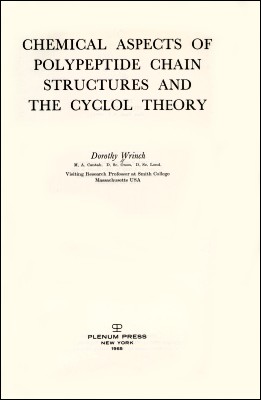Dorothy Wrinch
Chemical Aspects of Polypeptide Chain Structures and the Cyclol Theory
Plenum Press, New York, 1965

Table of Contents
- The cyclol hypotheses of peptide structure and organic chemical findings
- Introduction
- Some 'anomalous' findings relating to polypeptide chain structures
- 'Anomalies' regarding the active sites carried by enzymic proteins
- New finding relating to the synthesis and degradation of polypeptide chains
- Plan of the enquiry
- Chemical aspects of polypeptide chain structures in the cyclol system
- Introduction
- General proton migrations between polypeptide chains and the related transitions
- Transpeptidations in certain enzymic reactions and the cyclol hypothesis
- Some geometricochemical issues suggested by the cyclol hypothesis
- Introduction
- The general piperazine ring-closure
- The general hydantoin ring-closure
- Particular cases of the piperazine and hydantoin ring-closures
- The cyclol tripeptide of piperazine-hydantoin type
- Alternative ways of opening an amide grouping in a polypeptide chain
- Cyclizations in the case of a β- or γ-amino acid monomer in a polypeptide chain
- Syntheses of the two-bond peptide groupings by rearrangements
- Hydantoin peptides and certain well known rearrangements
- Rearrangements of tripeptide amides and 'carbonyl' tripeptides
- Chemical functions of reactive R side-chains in polypeptide chain structures in the extended amide system
- Introduction
- Acyclic and cyclic structures for (Ac,An) dipeptides, and their degenerations
- The synthesis of aspartyl dialanine, and branched chain polyamides as structures for peptides
- Various R, R'-joins between α-amino acid components of the same or different polypeptide chains
- R ring-closures within an N-terminal Ac component or a C-terminal An component of a polypeptide chain
- The reactivity of OH or SH groups carried by α-amino acid components of polypeptide chains
- Some individual R ring-closures within polypeptide chains in the extended cyclol system
- Introduction
- R ring-closures within glutamic acid and its peptides
- An intermonomer R ring-closure of a glutamic acid component of a polypeptide chain
- Alternative R ring-closures in a polypeptide chain having a glutamic acid component in its interior
- R ring-closures of other dicarboxy amine components of a polypeptide chain
- An intermonomer R ring-closure of an aspartic acid component of a polypeptide chain
- Intramonomer and intermonomer R ring-closures in polypeptide chains containing a diamino acid component
- Alternative R ring-closures in a polypeptide chain having a γ,α-diamino butyric acid component in its interior
- An R ring-closure of a hydroxy or sulfhydryl α-amino acid component of a polypeptide chain
- Ring-closures resulting in the excision of a terminal monomer of a polypeptide chain
- Model molecules suggested by individual R ring-closures
- R ring-closures of consecutive components of polypeptide chains
- Introduction
- Ring-closures of various kinds within Aglu–Adab fragments
- Ring-closures of various kinds within Aasp–Aser fragments
- Model molecules facilitating the study of certain labile three-bond groupings
- Alternative pathways to the synthesis of certain cyclol structures
- Mixed ring-closures within a polypeptide chain fragment
- Introduction
- Rearrangements in polypeptide chains
- Some lactone peptide structures
- The total synthesis of the ergotamine tripeptide
- Some additional synthetic cyclols and their identification by infrared spectra
- A more general problem awaiting solution
- Stereochemistry of cyclol compounds
- Some reactive R side-chains and alternative paths of cyclolization
- Certain double cyclol structures
- Depsi- and thiodepsi- peptides and the cyclol systems
- heats of formation of cyclol groupings
- Conclusions and growing points
- Introduction
- Some organic chemical targets
- Polypeptide chains carrying reactive R side-chains
- Synthesis of novel R,R'-joins within or between polypeptide chains
- Ring-closures in polypeptide chains containing dicarboxyamine components
- On the usefulness of formulating cyclol intermediates
- Interpretation of peptide chemical findings within the broader systems
- On the nature of the embedding of polypeptide chain fragments in intact peptide structures
- The chemical nature of the active sites on enzymic proteins
- Chemical events occurring during peptide synthesis and peptide degradation
- Polytransitions in biological systems
- Studies of cyclol chemical issues by way of model molecules
- Growing points in the new picture of polypeptide chain structures
- The idea of interdependent cyclolizations
Appendix One. On the present day version of the Cyclol Hypotheses with special reference to the liabilities of the multiple peptide groupings
Appendix Two. On linear polyamide structures
